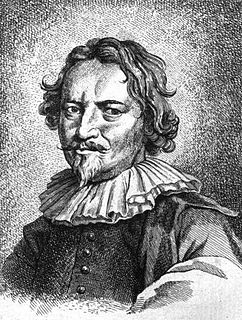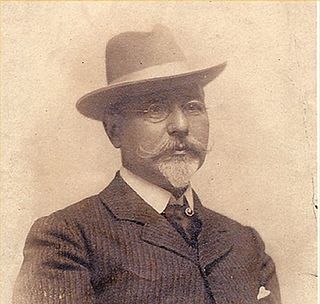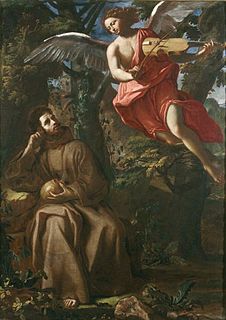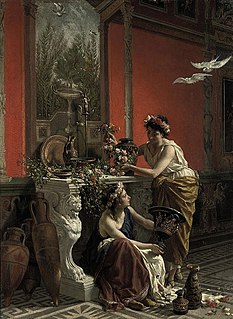This article needs additional citations for verification .(April 2013) |
Francesco Azzurri (Rome, 1831-1901) was an Italian architect. He was the nephew of the architect Giovanni Azzurri, a professor of architecture at the Academy of St. Luke in Rome.
This article needs additional citations for verification .(April 2013) |
Francesco Azzurri (Rome, 1831-1901) was an Italian architect. He was the nephew of the architect Giovanni Azzurri, a professor of architecture at the Academy of St. Luke in Rome.
Francesco studied Engineering and Architecture at the University of Rome, under San Bartolo and Sereni, afterward in the Accademia di San Luca under his uncle. He traveled extensively.
Most of his designs are inside Rome and include the isolated building in piazza Pollarola; the palazzo Pericoli in via di Monserrato; the palazzo Negroni, now palazzo Caffarelli in via de' Condotti, the Hotel Bristol in piazza Barberini, the park next to the Palazzo Barberini; the restoration of the Palazzo Venezia, the villa and studio of the Polish artist Hendrik Siemiradski, the new Teatro Nazionale (1880–86, now demolished), the Palazzo Pubblico of the Republic of San Marino, and various funeral chapels in the Campo Varano. He dedicated himself to designing for charitable institutions, including hospitals and asylums. His asylums for the mentally ill in Rome and Siena were models for others. He designed the hospital of the Fatebenefratelli (1867) in the Isola Tiberina, the Ospedale di Santa Maria della Pietà (1862), and enlarged the Ospedale Maggiore and the orphanage.
He became professor and president of the Accademia di San Luca in Rome. He was named Commissioner for the Edification of the Palazzo of Fine Arts in Rome, Municipal Consigliere, and member of the Commission Archeologica, Edilizia e degli Archivii. He was named Knight of Order Piano and of San Gregorio Magno, Commander of the Order of Francesco Giuseppe, Knight of the Order of the Crown of Italy, the Spanish Order of Isabel the Catholic, and the Order of San Marino. [1]



Francesco Borromini, byname of Francesco Castelli, was an Italian architect born in the modern Swiss canton of Ticino who, with his contemporaries Gian Lorenzo Bernini and Pietro da Cortona, was a leading figure in the emergence of Roman Baroque architecture.

Pietro da Cortona was an Italian Baroque painter and architect. Along with his contemporaries and rivals Gian Lorenzo Bernini and Francesco Borromini, he was one of the key figures in the emergence of Roman Baroque architecture. He was also an important designer of interior decorations.

Sebastiano Conca was an Italian painter.

Carlo Fontana was an Italian architect originating from today's Canton Ticino, who was in part responsible for the classicizing direction taken by Late Baroque Roman architecture.

Carlo Maratta or Maratti was an Italian painter, active mostly in Rome, and known principally for his classicizing paintings executed in a Late Baroque Classical manner. Although he is part of the classical tradition stemming from Raphael, he was not exempt from the influence of Baroque painting and particularly in his use of colour. His contemporary and friend, Giovanni Bellori, wrote an early biography on Maratta.

Pacentro is a comune of 1,279 inhabitants of the province of L'Aquila in Abruzzo, Italy. It is a well-preserved historic medieval village located in central Italy, several kilometers from the City of Sulmona about 170 kilometres (110 mi) east of Rome. Pacentro has been nominated as one of the "Borghi più belli d'Italia".

Filippo Barigioni (1690–1753) was an Italian sculptor and architect working in the Late Baroque tradition.

Ettore Roesler Franz was an Italian painter and photographer. He was among the most prolific Italian watercolorists and vedutisti of the late nineteenth century.

Francesco Cozza was an Italian painter of the Baroque period.

Filippo Raguzzini was an Italian architect best known for a range of buildings constructed during the reign of Benedict XIII.

Cesare Mariani was an Italian painter and architect of the late-19th century, active in Rome and Ascoli Piceno.
Giovanni Antinori was an Italian neoclassical architect. Employed by the papacy, he oversaw the re-erecting of three of Rome's obelisks - the Quirinale, the Sallustian and the Montecitorio.

Palazzo Marino is a 16th-century palace located in Piazza della Scala, in the centre of Milan, Italy. It has been Milan's city hall since 9 September 1861. It borders on Piazza San Fedele, Piazza della Scala, Via Case Rotte and Via Tommaso Marino.
Ignazio Jacometti was an Italian sculptor.

Tommaso Minardi was an Italian painter and author on art theory, active in Faenza, Rome, Perugia, and other towns. He painted in styles that transitioned from Neoclassicism to Romanticism.

Luigi "Gino" Coppedè was an Italian architect, sculptor and decorator. He was an exponent of Art Nouveau.

Palazzo Alicorni is a reconstructed Renaissance building in Rome, important for historical and architectural reasons. The palace, originally lying only a few meters away from Bernini's Colonnades in St. Peter's square, was demolished in 1930 in the wake of the process of the border definition of the newly established Vatican City state, and rebuilt some hundred meters to the east. According to the stylistic analysis, his designer had been identified as Giovanni Mangone, a Lombard architect active in Rome during the 16th century.

Giovanni Mangone was an Italian artist active almost exclusively in Rome during the Renaissance. Mangone's skills were manifold: he worked as sculptor, architect, stonecutter and building estimator. Moreover, he was a keen antiquarian and among the founders of the Academy dei Virtuosi al Pantheon. As military engineer, he was renowned among his contemporaries.

The Palace of the Vicariate or Palace of Maffei Marescotti is the name given to a religious building in Rome, Italy.

Pietro Gagliardi was an Italian painter and architect, who decorated many churches and palaces in Rome and throughout Italy.